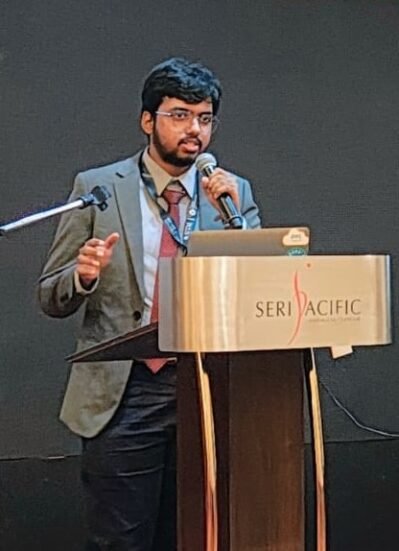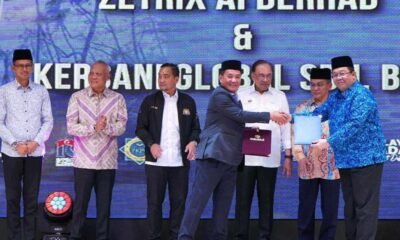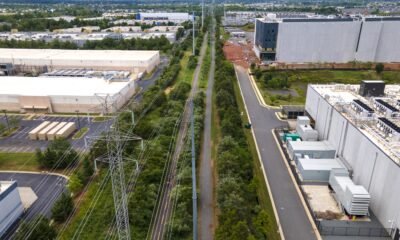AI Research
Researchers using AI for weather forecasting

Weather forecasting is not easy. The truth is that predicting future weather conditions over broad, or even narrow, swaths of Earth’s surface comes down to complex microphysical processes, and as College of Engineering Associate Professor and UConn Atmospheric and Air Quality Modeling Group Leader Marina Astitha puts it, nature is chaotic.
Astitha and her research group are at the forefront of exploring ways to improve weather prediction using AI and machine learning to enhance existing physics-based models. They developed new methods for the prediction of snowfall accumulation and wind gusts associated with extreme weather events in three recent papers published in the Journal of Hydrology, Artificial Intelligence for the Earth Systems, and another in the Journal of Hydrology.
Postdoctoral researcher Ummul Khaira Ph.D. ’24 led the snowfall prediction work during her time as a Ph.D student. Ph.D candidate Israt Jahan is passionate about building models that improve predictions of damaging wind gusts from storms.
The researchers met with UConn Today to discuss the importance and everyday applications of enhanced forecasting capabilities using these new technologies.
Are there forecasting challenges that are unique to the Northeast?
Astitha: There are characteristics about the Northeast that make it particularly difficult to make weather predictions for. This is especially true for winter weather because we have Nor’easters that can come from either the center of the country or from the Gulf. Some move slowly, and they are highly predictable. Some can be what we call a bomb cyclone, where they rush up here and dump a lot of snow in a small amount of time.
For weather forecasting, we traditionally use numerical weather prediction models that are based on physics principles and have seen large improvements over the last 20–30 years. We have been running our own weather forecasting system at UConn since 2014, based on physical models. However, numerical weather prediction comes with its own challenges due to uncertainty in parameterizations that are necessary when no physical laws are known for a specific process.
For windstorms, wind gusts specifically are a complicated variable. It’s wind, but the way we observe it and the way we model it is different.
Can you explain more about the physics used in numerical weather prediction models?
Astitha: Precipitation is a microscale process. As air rises and cools, clouds form, and within those clouds, tiny cloud droplets develop through complex microphysical interactions. Over time, some of these droplets grow large enough to become raindrops or snowflakes. Once they reach a critical size, gravity causes them to fall to the ground as precipitation. This entire process is governed by microphysical processes.
We try to predict such microphysical processes embedded in numerical weather models by solving many equations and parameterizations. These models describe our atmosphere as a 3D grid, dividing it into discrete boxes where we solve equations based on first principles (motion, thermodynamics, and more). This approach poses a major challenge: even with increased resolution, each grid cell often represents a large volume of air, typically one to four square kilometers. Despite efforts to refine the grid, these cells still encompass vast areas, limiting the model’s ability to resolve smaller-scale processes.
Numerical prediction is what got me here. 20 years ago, I could run a code to numerically solve physics equations of the atmosphere, and then I could tell approximately what the weather would be like the next day. That, to me, was mind-blowing!
Once you run one deterministic model, you get one answer that the temperature is going to be, say 75 degrees tomorrow in Storrs. That’s one potential realization of the future. Models like that are not capable of giving us an exact answer, because nature is chaotic. I’ve always had the mindset of looking at multiple models to have an idea of that uncertainty and variability, and if 10 different realizations give you 74, 75, or 76 degrees, you know you’re close.
Khaira: Few things are more humbling than a snowfall that defies prediction. My work lies in embracing that uncertainty in the chaos and building models not to promise perfection, but to offer communities and decision-makers a clearer window into what might lie ahead.
How is your recent research helping with the challenges of numerical weather prediction?
Astitha: Imagine a Nor’easter coming our way during wintertime; they come with a lot of snow and wind. We work with the Eversource Energy Center and we’re interested not only in the scientific advancement, but also the impact and accuracy in predicting when and where that storm is going to happen in Connecticut. Weather prediction accuracy influences the estimation of impacts; for example, power outages. We might underestimate or overestimate the impact by a lot. That makes winter storms of particular interest because of the impact they have on our society, our transportation networks, and electrical power distribution networks.
Five years ago, we decided to test whether a machine learning framework could help with wind gust and snowfall prediction. It comes with its own challenges and uncertainties, but we quickly saw that there is a lot of promise for these tools to correct errors and do better than what numerical weather prediction can do and at a fraction of the time. Machine learning and AI can help improve the analysis of wind gusts and snowfall, but these systems are not perfect either.
We want to be able to better predict storms over Connecticut and the Northeast U.S., which is why we started this exploration with ML/AI, even though most of the research out there about how to implement AI in weather prediction is either at the global scale or much coarser resolution, but we’re getting there.
Can you talk about the everyday impact of the research?
Astitha: An example is when the trees are full of leaves like they are in late spring and summer, and a storm comes in with a lot of rain and intense wind. Whole trees can come down and topple the power lines, which causes many disruptions around the state.
Our close collaboration with the Eversource Energy Center involves our immediate collaborators taking this weather prediction information and operationally predicting power outages for Connecticut and other service territories. That information can go to the utility managers, so they can prepare two to three days in advance, indicating a direct link from science and engineering to the application and to the manager.
I understand people’s frustrations and the need for answers about weather forecasts and impacts of storms. You want to know if your family is going to be safe and if you should or should not be out during particular times of the day. We’re doing this research to improve the reliability and accuracy of weather forecasting, so communities and stakeholders are aware of what’s happening when the storm hits their area and can take appropriate actions.
Jahan: It’s incredibly rewarding to know that my work has the potential to improve early warnings and give communities more time to prepare. By combining AI and uncertainty analysis, we’re not just making gust predictions more accurate—we are helping decision-makers plan with greater confidence.
More information:
Ummul Khaira et al, Investigating the role of temporal resolution and multi-model ensemble data on WRF/XGB integrated snowfall prediction for the Northeast United States, Journal of Hydrology (2025). DOI: 10.1016/j.jhydrol.2025.133313
Israt Jahan et al, Storm Gust Prediction with the Integration of Machine Learning Algorithms and WRF Model Variables for the Northeast United States, Artificial Intelligence for the Earth Systems (2024). DOI: 10.1175/AIES-D-23-0047.1
Ummul Khaira et al, Integrating physics-based WRF atmospheric variables and machine learning algorithms to predict snowfall accumulation in Northeast United States, Journal of Hydrology (2024). DOI: 10.1016/j.jhydrol.2024.132113
Provided by
University of Connecticut
Citation:
Researchers using AI for weather forecasting (2025, July 8)
retrieved 8 July 2025
from https://phys.org/news/2025-07-ai-weather.html
This document is subject to copyright. Apart from any fair dealing for the purpose of private study or research, no
part may be reproduced without the written permission. The content is provided for information purposes only.
AI Research
Measuring Machine Intelligence Using Turing Test 2.0

In 1950, British mathematician Alan Turing (1912–1954) proposed a simple way to test artificial intelligence. His idea, known as the Turing Test, was to see if a computer could carry on a text-based conversation so well that a human judge could not reliably tell it apart from another human. If the computer could “fool” the judge, Turing argued, it should be considered intelligent.
For decades, Turing’s test shaped public understanding of AI. Yet as technology has advanced, many researchers have asked whether imitating human conversation really proves intelligence — or whether it only shows that machines can mimic certain human behaviors. Large language models like ChatGPT can already hold convincing conversations. But does that mean they understand what they are saying?
In a Mind Matters podcast interview, Dr. Georgios Mappouras tells host Robert J. Marks that the answer is no. In a recent paper, The General Intelligence Threshold, Mappouras introduces what he calls Turing Test 2.0. This updated approach sets a higher bar for intelligence than simply chatting like a human. It asks whether machines can go beyond imitation to produce new knowledge.
From information to knowledge
At the heart of Mappouras’s proposal is a distinction between two kinds of information, non-functional vs. functional:
- Non-functional information is raw data or observations that don’t lead to new insights by themselves. One example would be noticing that an apple falls from a tree.
- Functional information is knowledge that can be applied to achieve something new. When Isaac Newton connected the falling apple to the force of gravity, he transformed ordinary observation into scientific law.
True intelligence, Mappouras argues, is the ability to transform non-functional information into functional knowledge. This creative leap is what allows humans to build skyscrapers, develop medicine, and travel to the moon. A machine that merely rearranges words or retrieves facts cannot be said to have reached the same level.
The General Intelligence Threshold
Mappouras calls this standard the General Intelligence Threshold. His threshold sets a simple challenge: given existing knowledge and raw information, can the system generate new insights that were not directly programmed into it?
This threshold does not require constant displays of brilliance. Even one undeniable breakthrough — a “flash of genius” — would be enough to demonstrate that a machine possesses general intelligence. Just as a person may excel in math but not physics, a machine would only need to show creativity once to prove its potential.
Creativity and open problems
One way to apply the new test is through unsolved problems in mathematics. Throughout history, breakthroughs such as Andrew Wiles’s proof of Fermat’s Last Theorem or Grigori Perelman’s solution to the Poincaré Conjecture marked milestones of human creativity. If AI could solve open problems like the Riemann Hypothesis or the Collatz Conjecture — problems that no one has ever solved before — it would be strong evidence that the system had crossed the threshold into true intelligence.
Large language models already solve equations and perform advanced calculations, but solving a centuries-old unsolved problem would show something far deeper: the ability to create knowledge that has never existed before.
Beyond symbol manipulation
Mappouras also draws on philosopher John Searle’s famous “Chinese Room” thought experiment. In the scenario, a person who does not understand Chinese sits in a room with a rulebook for manipulating Chinese characters. By following instructions, the person produces outputs that convince outsiders he understands the language, even though he does not.
This scenario, Searle argued, shows that a computer might appear intelligent without real understanding. Mappouras agrees but goes further. For him, real intelligence is proven not just by producing outputs, but by acting on new knowledge. If the instructions in the Chinese Room included a way to escape, the person could only succeed if he truly understood what the words meant. In the same way, AI must demonstrate it can act meaningfully on information, not just shuffle symbols.
Can AI pass the new test?
So far, Mappouras does not think modern AI has passed the General Intelligence Threshold. Systems like ChatGPT may look impressive, but their apparent creativity usually comes from patterns in the massive data sets on which they were trained. They have not shown the ability to produce new, independent knowledge disconnected from prior inputs.
That said, Mappouras emphasizes that success would not require constant novelty. One true act of creativity — an undeniable demonstration of new knowledge — would be enough. Until that happens, he remains cautious about claims that today’s AI is truly intelligent.
A shift in the debate
The debate over artificial intelligence is shifting. The original Turing Test asked whether machines could fool us into thinking they were human. Turing Test 2.0 asks a harder question: can they discover something new?
Mappouras believes this is the real measure of intelligence. Intelligence is not imitation — it is innovation. Whether machines will ever cross that line remains uncertain. But if they do, the world will not just be talking with computers. We will be learning from them.
Final thoughts: Today’s systems, tomorrow’s threshold
Models like ChatGPT and Grok are remarkable at conversation, summarization, and problem-solving within known domains, but their strengths still reflect pattern learning from vast training data. By Mappouras’s standard, they will cross the General Intelligence Threshold only when they produce a verifiable breakthrough — an insight not traceable to prior text or human scaffolding, such as an original solution to a major open problem. Until then, they remain powerful imitators and accelerators of human work — impressive, useful, and transformative, but not yet creators of genuinely new knowledge.
Additional Resources
AI Research
UTM Celebrates Malaysia’s Youngest AI Researcher Recognised at IEEE AI-SI 2025 – UTM NewsHub

KUALA LUMPUR, 28 August 2025 – Universiti Teknologi Malaysia (UTM) proudly hosted the Institute of Electrical and Electronics Engineers (IEEE) International Conference on Artificial Intelligence for Sustainable Innovation (AI-SI) 2025, themed “Empowering Innovation for a Sustainable Future.” The conference gathered global experts, academics, and industry leaders to explore how Artificial Intelligence (AI) can address sustainability challenges. Among its highlights was the remarkable achievement of 17-year-old Malaysian researcher, Charanarravindaa Suriess, who was celebrated as the youngest presenter and awarded Best Presenter for his groundbreaking paper on adversarial robustness in neural networks. His recognition reflected not only individual brilliance but also Malaysia’s growing strength in the global AI research landscape.
Charanarravindaa’s presentation, titled “Two-Phase Evolutionary Framework for Adversarial Robustness in Neural Networks,” introduced an innovative framework designed to improve AI systems’ ability to defend against adversarial attacks. His contribution addressed one of the most pressing challenges in AI, ensuring resilience and trustworthiness of machine learning models in real-world applications. Born in Johor Bahru, his journey into science and computing began early; by primary school, he was already troubleshooting computers and experimenting with small websites. At just 15 years old, he graduated early, motivated by a passion for deeper challenges. Participation in international hackathons, including DeepLearning Week at Nanyang Technological University (NTU) Singapore, strengthened his resolve and provided the encouragement that led to his first academic paper, now internationally recognised at IEEE AI-SI 2025.
Beyond academia, Charanarravindaa has also demonstrated entrepreneurial spirit by founding Cortexa, a startup dedicated to advancing AI robustness, architectures, and applied AI for scientific discovery. His long-term vision is to integrate artificial intelligence with quantum computing and theoretical physics to expand the boundaries of knowledge. This ambition is a testament to the potential of Malaysia’s youth in contributing to frontier technologies. His recognition at IEEE AI-SI 2025 reflects IEEE’s mission of advancing technology for humanity, where innovation is seen as a universal endeavour not limited by age. By honouring a young researcher, IEEE underscored its commitment to empowering future generations of scientists and innovators to shape technology for global good.

During the conference, the Faculty of Artificial Intelligence (FAI), UTM, represented by Associate Professor Dr. Noor Azurati Ahmad, extended an invitation to Charanarravindaa to explore possible research collaborations. This initiative aligns with FAI’s vision to be a leader in AI education, research, and innovation, with a particular focus on trustworthy, robust, and sustainable AI. Early discussions centred on aligning his research interests with UTM’s expertise in advanced architectures and digital sustainability. Such collaboration exemplifies how institutions and young talent can come together to accelerate innovation, while also strengthening Malaysia’s position as an emerging hub for AI research and talent cultivation.
At the national level, this achievement resonates strongly with the Malaysia National Artificial Intelligence Roadmap (2021–2025), which identifies talent development as a central pillar in building an AI-ready nation. Prime Minister Datuk Seri Anwar Ibrahim has repeatedly highlighted the urgency of nurturing local talent to enhance competitiveness and leadership in the global digital economy. Charanarravindaa’s success demonstrates tangible progress in this direction, showcasing how Malaysia can produce young innovators capable of contributing to both national aspirations and international scientific advancement. Through platforms such as IEEE AI-SI 2025, UTM reaffirms its role as a catalyst for excellence in AI research and talent development, embodying its mission to prepare the next generation of scholars and innovators who will drive sustainable futures.
AI Research
Databricks at a crossroads: Can its AI strategy prevail without Naveen Rao?

“Databricks is in a tricky spot with Naveen Rao stepping back. He was not just a figurehead, but deeply involved in shaping their AI vision, particularly after MosaicML,” said Robert Kramer, principal analyst at Moor Insights & Strategy.
“Rao’s absence may slow the pace of new innovation slightly, at least until leadership stabilizes. Internal teams can keep projects on track, but vision-driven leaps, like identifying the ‘next MosaicML’, may be harder without someone like Rao at the helm,” Kramer added.
Rao became a part of Databricks in 2023 after the data lakehouse provider acquired MosaicML, a company Rao co-founded, for $1.3 billion. During his tenure, Rao was instrumental in leading research for many Databricks products, including Dolly, DBRX, and Agent Bricks.
-

 Business2 weeks ago
Business2 weeks agoThe Guardian view on Trump and the Fed: independence is no substitute for accountability | Editorial
-
Tools & Platforms1 month ago
Building Trust in Military AI Starts with Opening the Black Box – War on the Rocks
-

 Ethics & Policy2 months ago
Ethics & Policy2 months agoSDAIA Supports Saudi Arabia’s Leadership in Shaping Global AI Ethics, Policy, and Research – وكالة الأنباء السعودية
-

 Events & Conferences4 months ago
Events & Conferences4 months agoJourney to 1000 models: Scaling Instagram’s recommendation system
-

 Jobs & Careers2 months ago
Jobs & Careers2 months agoMumbai-based Perplexity Alternative Has 60k+ Users Without Funding
-

 Podcasts & Talks2 months ago
Podcasts & Talks2 months agoHappy 4th of July! 🎆 Made with Veo 3 in Gemini
-

 Education2 months ago
Education2 months agoMacron says UK and France have duty to tackle illegal migration ‘with humanity, solidarity and firmness’ – UK politics live | Politics
-

 Education2 months ago
Education2 months agoVEX Robotics launches AI-powered classroom robotics system
-

 Podcasts & Talks2 months ago
Podcasts & Talks2 months agoOpenAI 🤝 @teamganassi
-

 Funding & Business3 months ago
Funding & Business3 months agoKayak and Expedia race to build AI travel agents that turn social posts into itineraries





















